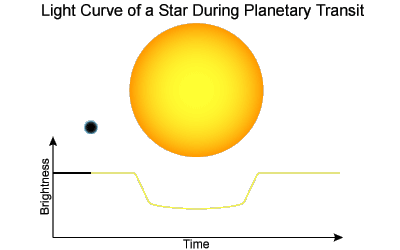 |
Department of Physics | AstroLab |
Studying Exoplanets from Transit Light Curves
An increasing number of extra-solar planets have been identified orbiting stars. Since a planet is extremely faint compared to the parent star, very few of the extrasolar planets have been observed directly. Instead, the most common approach to identify and characterise extrasolar planets is to use the transit method in which the visual brightness of the star drops by a small fraction as the planet transits in front of the star.

The light curves from the transits are rich with information. By measuring the depth of the change in brightness, together with an estimate of the size of the star, we can determine the radius of the planet. The orbital period of the planet can be determined by measuring the elapsed time between transits, and by applying Kepler's Third Law of Planetary Motion, we can also determine the average distance of the planet from its star. Together these can be used to search for planets in "habitable zones" - the zone in which water should be able to exist in a liquid state.
The aim of this project is to measure the light curves caused by exoplanet transits in order to characterise the properties of the extrasolar planets. By choosing exoplanets in fields with non-varying stars, the light curve can be determined from a series of measurements which compare the relative brightnesses.
HAT-P 16b
The exoplanet around star HAT-P 16 has a transit period of 3 hours and a depth of 0.02 magnitudes. Below is the light curve for HAT-P-16b as measured by the Durham 16-inch Far-East Telescope in February 2020. The dataset has been modelled with the Mandel-Algol transit equations using PyTransit. The residual plot is shown below, with +/-1-sigma highlighted.
 |
Project Notes Project References
| Back to the AstroLab Home Page | jrl | 2020-Jun-17 13:41:12 UTC |